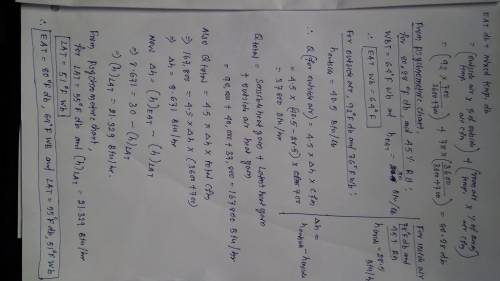
Engineering, 18.12.2019 04:31, kkpowell
Aroom in a building has the following characteristics: sensible heat gain: 90,000 btu/hr, latent heat gain: 40,000 btu/hr, supply air: 3,600 cfm @ 55 deg. f db
air ventilation: 700 cfm, the room is kept at 78 deg. f db and 45% rh. outdoor air is 92 deg. f db 76 deg. f wb.
what is the wet bulb wb air temperature entering eat and wb temperature of air leaving the cooling coils lat in the room?
[lat = 55 deg. f db, given, need to calculate eat db, lat wb. the eat db of the air entering the cooling coils is the mixed temperature = [(room temp db)(2,900) cfm + (outside air temp db)(700)]/3,600 cfm. find eat wb and h of eat from chart. find h of outside air from chart. then q for outside air = (4.)(cfm) where cfm is outside air ventilation = about 26,800 btu/hr (show this), then total q = (sensible heat gain) + (latent heat gain) + (outside air heat gain) = about 157,000 btu/hr (show this), then total q = (4.)(total cfm), then find (? h) from total q, then find h of leaving air from ? h, then find wb temp of leaving air lat wb from chart. we get eat = 80.7 deg. f db/66.2 deg. f wb, lat = 51.7 deg. f wb.]

Answers: 3
Other questions on the subject: Engineering

Engineering, 04.07.2019 18:10, johnthienann58
Thermal stresses are developed in a metal when its a) initial temperature is changed b) final temperature is changed c) density is changed d) thermal deformation is prevented e) expansion is prevented f) contraction is prevented
Answers: 2

Engineering, 04.07.2019 18:20, hayleymckee
Steam enters a converging nozzle at 3.0 mpa and 500°c with a at 1.8 mpa. for a nozzle exit area of 32 cm2, determine the exit velocity, mass flow rate, and exit mach number if the nozzle: negligible velocity, and it exits (a) is isentropic (b) has an efficiency of 94 percent
Answers: 2

Engineering, 04.07.2019 18:20, aly95
An engine runs on the ideal diesel cycle. the cycle has a compression ratio of 20 and a cutoff ratio of 2. the highest temperature in the cycle is 1200 k. if the heat into the system is 300 kj/kg of working fluid and using variable specific heats determine the work produced per mass of working fluid
Answers: 3

Engineering, 04.07.2019 19:10, juneham
Estimate the change in specific internal energy au and specific enthalpy h from inlet to outlet for ethylene glycol (a liquid) flowing through each of the following devices: (a) a heat exchanger where the glycol temperature increases from 20 °c to 80 °c; (b) a pump operating at about 25 °c and increasing the glycol pressure from 100 kpa to 8 mpa.
Answers: 2
Do you know the correct answer?
Aroom in a building has the following characteristics: sensible heat gain: 90,000 btu/hr, latent h...
Questions in other subjects:



Mathematics, 12.09.2019 02:20


Biology, 12.09.2019 02:20

Mathematics, 12.09.2019 02:20


Chemistry, 12.09.2019 02:20

English, 12.09.2019 02:30

Mathematics, 12.09.2019 02:30







